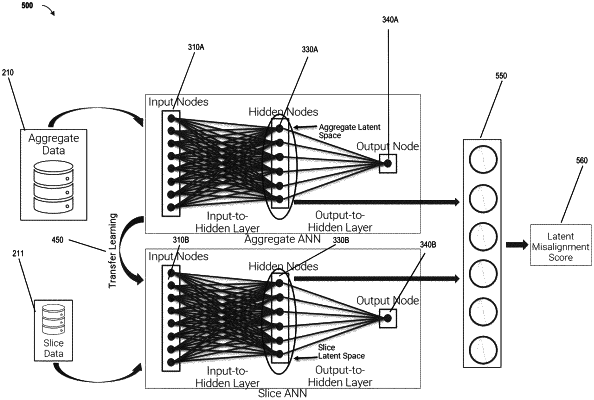| CPC G06N 3/088 (2013.01) [G06N 3/045 (2023.01)] | 13 Claims |

|
1. A computer-implemented method for providing improved insights about misalignment in latent space of a machine learning model, a first artificial neural network comprising a first weight matrix and an aggregate artificial neural network associated with an aggregate data set, a second artificial neural network comprising a second weight matrix and a slice artificial neural network associated with a subset of the aggregate dataset, the method comprising:
initializing, by one or more programmable processors, the second weight matrix of the second artificial neural network based on the first weight matrix of the first artificial neural network using a first training set, the second weight matrix optimized via back-propagation based on training the second artificial neural network based on the subset of the aggregate dataset comprising a data slice of the aggregated data set;
applying, by the one or more programmable processors, transfer learning between the first artificial neural network and the second artificial neural network, the first artificial neural network including first hidden nodes defining a first latent space from the first weight matrix, the second artificial neural network including transfer learned second hidden nodes defining a second latent space based on the second weight matrix;
comparing, by the one or more programmable processors, the first latent space with the second latent space to determine a statistical distance measurement between the first latent space and the second latent space, the comparing comprising applying a normalization formula to determine a distance measure for latent space misalignment, the distance measure indicating a measure of distance between the first latent space and the second latent space determined by a statistical measure distance between at least one hidden node of the second artificial neural network and at least one hidden node of the aggregate artificial neural network based on a distribution of hidden node activation values on data slice hidden node activation values of the aggregate artificial neural network;
determining, by the one or more programmable processors and responsive to the comparing, a first score indicating alignment of the first latent space and the second latent space; and
determining, by the one or more programmable processors and responsive to the first score satisfying a threshold, whether there is a latent space misalignment between the first latent space and the second latent space by multiplying the distance measure by an absolute value of a corresponding hidden-to-output weight value in the aggregate artificial neural network.
|